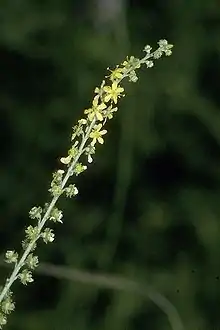| Agrimonia striata | |
|---|---|
 | |
| Inflorescence A. striata | |
| Scientific classification | |
| Kingdom: | Plantae |
| Clade: | Tracheophytes |
| Clade: | Angiosperms |
| Clade: | Eudicots |
| Clade: | Rosids |
| Order: | Rosales |
| Family: | Rosaceae |
| Genus: | Agrimonia |
| Species: | A. striata |
| Binomial name | |
| Agrimonia striata | |
Agrimonia striata (roadside agrimony, grooved agrimony,[1] agrimony, cocklebur, woodland agrimony,[2] woodland grooveburr[3]) is a species of perennial forb belonging to the rose family (Rosaceae). It grows to about 40 inches (1m) producing a dense cluster (raceme) of 5-parted yellow flowers on a hairy stalk above pinnately-divided leaves.[1] It is native to the United States, Canada, and Saint Pierre and Miquelon.[4] It is susceptible to downy mildew caused by the oomycete species Peronospora agrimoniae.[5]
The species name striata means "striped".[1]
References
- 1 2 3 Robert W. Freckmann Herbarium University of Wisconsin - Stevens Point Archived 2011-09-28 at the Wayback Machine Retrieved 2010-03-13.
- ↑ Gustave J. Yaki@Talk About Wildlife Archived 2011-07-06 at the Wayback Machine Retrieved 2010-03-13.
- ↑ ITIS Standard Report Page: Agrimonia Striata Retrieved 2010-03-13.
- ↑ PLANTS Profile for Agrimonia striata Retrieved 2010-03-13.
- ↑ Constantinescu, O. (1991). "An annotated list of Peronospora names". Thunbergia. 15.
This article is issued from Wikipedia. The text is licensed under Creative Commons - Attribution - Sharealike. Additional terms may apply for the media files.